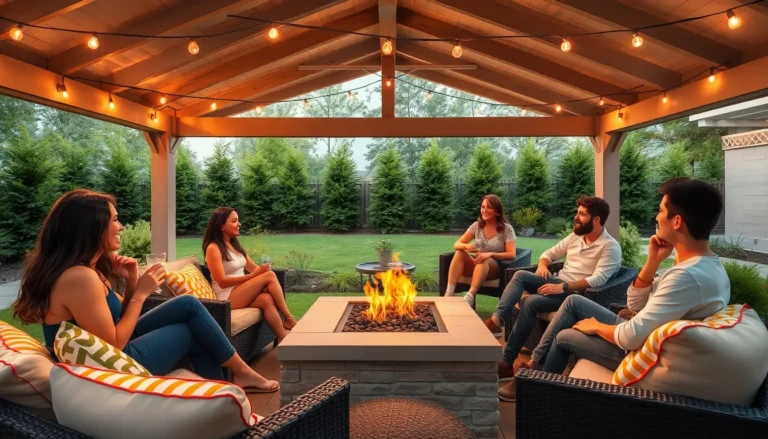Table of Contents
ToggleNavigating the world of home insurance can feel overwhelming, but it doesn’t have to be. With the right tips and knowledge, homeowners can secure the best coverage at the most affordable rates. Understanding the ins and outs of home insurance not only protects one’s investment but also provides peace of mind.
From assessing coverage needs to comparing policies, small steps can lead to significant savings. Homeowners often overlook essential factors that could impact their premiums and coverage options. By staying informed and proactive, they can make smarter decisions that safeguard their homes and finances.
Understanding Home Insurance
Home insurance protects homeowners against various risks, including damage to property and liability for injuries occurring on their premises. Knowing the key components of home insurance is crucial for making informed decisions.
What Is Home Insurance?
Home insurance, also known as homeowner’s insurance, covers financial losses resulting from damage to a home or its contents. It typically includes protection against hazards such as fire, theft, and storms. Home insurance also protects homeowners from potential legal liabilities arising from accidents that occur on their property. It combines property insurance and liability coverage in a single policy, offering a comprehensive safety net for homeowners.
Types of Home Insurance Policies
Homeowners can choose from several types of policies based on their specific needs:
- HO-1 (Basic Form): Covers essential perils, including fire and theft, but offers limited protection.
- HO-2 (Broad Form): Offers more extensive coverage than HO-1, protecting against specific risks listed in the policy.
- HO-3 (Special Form): Provides comprehensive protection for the structure and named perils for personal belongings.
- HO-4 (Renters Insurance): Protects tenants’ personal property but doesn’t cover the dwelling itself.
- HO-5 (Comprehensive Form): Offers the most extensive coverage, protecting both the structure and personal belongings on an open peril basis.
- HO-6 (Condo Insurance): Provides coverage tailored for condominium owners, focusing on personal property and improvements.
- HO-7 (Mobile Home Insurance): Specifically designed for mobile or manufactured homes, covering similar perils as HO-3.
- HO-8 (Modified Coverage): Suitable for older homes, this policy adjusts coverage based on actual cash value instead of replacement cost.
Selecting the right policy depends on individual circumstances, including the home’s location, condition, and personal property value. Homeowners benefit from evaluating these options to ensure adequate protection tailored to their specific housing situations.
Essential Home Insurance Tips

Homeowners can make informed decisions about their home insurance through key strategies. Understanding coverage needs and selecting appropriate deductibles significantly impacts both protection and cost.
Assessing Your Coverage Needs
Assess coverage requirements by evaluating home value and personal assets. Identify risks specific to the location, such as floods, earthquakes, or theft, to tailor the policy effectively. Review each policy type, including HO-3 and HO-5, to determine if additional coverage for personal valuables or specific hazards is necessary. Regularly reassess coverage, especially after significant life changes like renovations or acquiring new assets, to ensure adequate financial protection.
Choosing the Right Deductible
Choose a deductible that aligns with personal financial situations. Higher deductibles often lead to lower premiums, making monthly expenses more manageable. Analyze past claims and current budget capabilities when determining the deductible amount. Experts recommend evaluating the potential out-of-pocket costs against potential savings on premiums to strike an optimal balance.
Common Mistakes to Avoid
Homeowners often make critical mistakes during the insurance process, leading to inadequate coverage and higher costs. Recognizing these errors can help ensure proper protection and savings.
Underestimating Home Value
Underestimating home value can lead to insufficient coverage. Homeowners must accurately assess the replacement cost of their property, not just the market value. Factors affecting this assessment include materials used in construction, local labor costs, and any upgrades or renovations. A proper evaluation may involve professional appraisals or using online calculators. Homes in high-risk areas may require additional coverage, so incorporating these variables is vital for accurate policy selection.
Overlooking Special Discounts
Overlooking special discounts often results in higher premiums. Many insurers provide discounts based on various factors, such as home security systems, customer loyalty, or bundling policies. Homeowners should inquire about all available discounts to optimize their coverage. Reviewing qualifications for claims-free history or participating in home safety courses may also yield savings. Being proactive in understanding and utilizing these discounts significantly lowers overall insurance costs.
Maintaining Your Home Insurance
Maintaining home insurance involves proactive measures to ensure adequate coverage and cost-effectiveness. Regular assessments and timely updates are crucial for effective protection.
Regularly Reviewing Your Policy
Reviewing a home insurance policy annually ensures it aligns with current needs and market conditions. Homeowners should check for changes in property value, repair costs, and local risks that could impact coverage. Many insurers offer policy updates, so understanding the terms and any newly added endorsements is vital. He or she should also evaluate premium rates, comparing them with similar coverage options to spot potential savings. Consider checking for available discounts that may apply based on home safety features or affiliations with specific organizations.
Updating Coverage After Major Changes
Updating home insurance coverage after significant life events is essential. Homeowners should adjust policies when they undertake renovations or improvements that increase home value. Adding new structures, such as decks or swimming pools, warrants revisiting liability coverage as well. A change in household composition, such as acquiring a roommate or welcoming a newborn, necessitates a reevaluation of personal property coverage. When relocating, consider the different risks associated with the new area, and ensure the policy reflects these changes adequately.
Homeowners can significantly benefit from understanding the nuances of home insurance. By taking the time to assess their coverage needs and regularly reviewing their policies, they can ensure adequate protection for their properties. Recognizing the importance of deductibles and identifying potential discounts can lead to substantial savings.
Staying informed about local risks and market conditions allows homeowners to make proactive adjustments to their coverage. This vigilance not only safeguards their financial investments but also provides peace of mind. With the right approach, homeowners can navigate the complexities of home insurance effectively and confidently.




